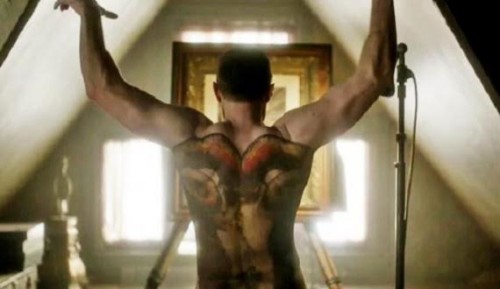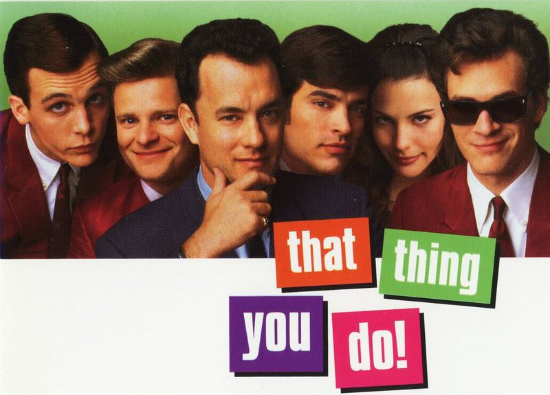This guest post by Lisa Anderson appears as part of our theme week on The Female Gaze.
In discussing the female gaze in media, there’s one television show worth considering that may come as a surprise: NBC’s Hannibal. This plucky little drama has toiled away in bad time slots for three seasons now, winning critical accolades and devoted followers that never translated into ratings. In a landscape littered with crime procedurals that exploit women, Hannibal stands out, and not just for its searing visuals or plot twists. There are three ways that the “gaze” in Hannibal is feminine: the way the show depicts women, the way it depicts men, and the way it depicts sex.
You only need start with the pilot to see that Hannibal is a different sort of show. Not only does it cast two characters who were men in the original novels by Thomas Harris as women – Freddy (Freddie) Lounds and Alan (Alana) Bloom, to be specific – but it gives beefed-up rolls to three characters who weren’t central to the novels’ plots. Those are Jack Crawford’s wife Phyllis, forensic investigator Beverly Katz, and Abigail Hobbes, the daughter of serial killer Garrett Jacob Hobbs. Yet another female character, Hannibal Lecter’s psychiatrist Bedelia DuMaurier, is created from whole cloth. Showrunner Bryan Fuller has been quoted as saying he balanced the cast this way in part because writing a show with only men would have been boring.
As remarkable as the living women in the cast, however, is the way that the show treats dead women, right from the start. Much ink has been spilled about how many law enforcement procedurals fetishize the torture and suffering of women, or depict female murder victims in a titillating way. By contrast, in the opening moments of Hannibal, the protagonist, Will Graham, invites his students (and the viewers) to empathize with a dying murder victim, not with her killer–in spite of his own unfortunate gift for doing the opposite. As he is drawn into the FBI’s investigations of Hobbs’s murders, the first victim is found tucked respectfully into bed, fully clothed. The second crime scene he visits turns out to be one of Hannibal Lecter’s infamous murder tableaus, and while the dead woman there is naked –impaled on antlers – her body is angled in such a way her gender isn’t obvious and the image is fit for network TV.
Hannibal continues its gender-neutral approach to serial murder throughout its run. As many men are murdered as women (if not more), and whenever corpses are found without clothes on, they are shot such a way that they register as human rather than male or female. (The victims of the Muralist in Season 2 are perhaps the best example of this.) Even when a bare breast is shown straight on (such as with one critical character death in Season 2), it goes by quickly and is soft-focused and the nipple is not shown. Most importantly, the murders on Hannibal aren’t driven by misogyny or some twisted sexual motivation. This is not reflective of real of serial killers at all, but the show is more interesting for it. The one exception is Frances Dolarhyde, who comes on the scene in the back half of Season 3, and whose sexual pathology is impossible to get around. Even there, though, his female victims aren’t depicted in a titillating way.
Surely just having lots of good female characters and not depicting crime in a creepy way doesn’t qualify a show has having the female gaze, though, right? No, and in the case of Hannibal, there’s more to it than that. The show makes the most of the attractive male actors in its cast (and their avid fans), and also centers female pleasure in its sex scenes without exploiting the actresses.
The first (and very unsettling) instance of the female gaze that I noticed in Hannibal centers around the above-mentioned Mr. Graham, played by the amazing Hugh Dancy. Early in Season 1, Graham uses his talent for empathy to imagine himself in the place of a mental hospital inmate played by Eddie Izzard. As he mentally reconstructs a murder committed in the hospital by Izzard’s character, we see him with his shirt unbuttoned, smirking at the victim with a mix of smolder and menace before attacking her. In that moment, Dancy seems to be channeling Eddie Izzrard’s own sex appeal. Nor was that the only time the show has made the most of Dancy’s looks: it’s not common for him to be seen shirtless, but it’s not unusual either, and fans on tumblr have gleefully traded stills of the show that feature his rear end. In terms of Will the character, there is, of course, a perennial appeal to a cute man in glasses and cold-weather clothes scritching a dog… but maybe that’s just me. (I doubt it.)
In terms of the female gaze in Hannibal, however, no character is more important than the titular serial killer, played by Mads Mikkelsen. Sex appeal is part of the “Person Suit” that Lecter puts on, whether it’s the dapper, cultured professional that he puts forward in seasons 1 and 2, or the leather-clad, globe-trotting bad boy that begins Season 3. It’s not to lure his victims, though; it’s to conceal his crimes from society. Nor do clothes always make the man–in Season 2, the audience is treated to a slow pan up Mikkelson’s body as he is clad in only swim trunks. (In another example of the show’s twisted vision, Lecter is actually in dire straights at that moment.) In Season 3, there is a brief-but-langorous sequence of Lecter showing off blood. He emerges from the bathroom to have a tense confrontation with another character, rendered decent only by prop placement that would make Austin Powers proud.
The staff of Hannibal make the most of both their talented and attractive lead and the fans’ appreciation for him. The show’s official tumblr literally teased fans for weeks with the prospect of their favorite cannibal in a swimsuit. Even the show’s hilarious and inimitable food stylist, Janice Poon, has described Mikkelson as the “man o’ dreams,” as she jokingly (?) lamented missing the opportunity to brush glaze onto him.
The show’s eye candy doesn’t end with Mikkelson and Dancy, either. Richard Armitage, of Hobbit and North and South fame, joined the cast in Season 3 as Francis Dolarhyde, the Great Red Dragon. Right from his first, dialogue-free scene, he meets the high bar for acting set by Dancy and Mikkelson. But he also got into fighting shape to play the body-building villain of Harris’ novel, and for the most part, if Dolarhyde is in private, he is either wearing only small shorts or implied to be naked.
The way Dolaryhyde is filmed for Hannibal points to the difference between how depicts men and women. His nudity is not necessarily supposed to be titillating – it’s mainly to show off his formidable form and the vivid tattoo on his back, although it certainly won’t be unappealing to those who go in for muscular men. What it is, though, is gendered. By contrast, in the pilot, we see Freddie Lounds sitting at her computer, with her back turned and no shirt on. The mood is casual (especially in comparison to Dolarhyde’s workouts), and there is no posing for a camera that shouldn’t be there, no implication that she might turn. She’s treated as a naked human, not a naked woman. The same comparison can be made between Lecter’s Season 3 shower and the baths taken Dr. DuMaurier, played by Gillian Anderson. The show treats the bodies of living women with the same respect that it treats those of dead ones.
So, what happens when the men and women of Hannibal get together? Speaking strictly in terms of what’s been confirmed onscreen, we’ve had a couple of opportunities to find out. Women are seduced by (and seduce) serial killers, a lesbian character sleeps with a man to get pregnant but later finds a female partner, and there’s even a hallucinatory “five-way” that involves people hooking up with people while thinking of other people (and also… a wendigo. It’s hard to explain). If it all sounds sensational and potentially problematic, only the first part of that is true.
The sex scenes in Hannibal have a few things in common. First, neither female nor male bodies are really exploited. This could be written off as owing to network TV, the networks manage the male gaze just fine in their sex scenes most of the time. Instead, there’s a dream-like, almost art-house quality to the editing and camerawork. Second, they’re always between central, full-drawn characters, who are both acting out of their agency even if there is information that they don’t have. Third, they all have strategic or plot importance – the feelings of the characters and the dynamics between them are as important as what happens physically.
Most importantly, though, the sex scenes in Hannibal always imply that the woman (or women) involved are satisfied. This is usually done with a tasteful shot of an arched back or ecstatic facial expression. Remarkably, in a show where interpersonal relationships of all kinds prove to be fraught and painful, there’s never been a sex scene where it wasn’t clear that a woman was having a good time. This focus on female pleasure, as much as anything else, qualifies Hannibal as a show with a female gaze.
While Hannibal’s female gaze obviously includes the straight female gaze, it’s not strictly heteronormative. Dr. Alana Bloom, played by Caroline Dhavernas, is attracted to both Will and Hannibal, but ultimately ends up in a long-term relationship with a woman. Will and Hannibal both get involved with women, but in a Episode 10 of Season 3, Bedelia DuMaurier – perhaps the person most in Hannibal’s confidence – heavily and repeatedly implies that they’ve been sexual with each other as well. Many viewers were surprised only by the confirmation, based on the homoerotic subtext between the two from the start. While Hannibal still has never had a gay man as one of the central characters, it acknowledges both male and female bisexuality, which is unfortunately a rarity on TV today. Needless to say, this wins the show points in today’s fandom environment, with it’s overlapping interest in social justice and same-sex pairings.
I’m not saying that Hannibal is a perfect show. Feminists have taken issue with it before. I’ve agreed with some of those criticisms and either disagreed with or eventually softened my position on others. With two more episodes left in Season 3 as of this writing, I can imagine ways in which it could still disappoint me. At the end of the day, though, it explodes many of the misogynist tropes of the TV crime procedural and even the texts where it finds its roots, and makes something truly unique and darkly beautiful with the shards.
Sadly, Hannibal has been canceled by NBC, and has not yet found another financial backer. I hope that it finds one, because I’d love for Bryan Fuller to be able to complete his vision. Until then, I’ll probably revisit it on DVD, and encourage those who I think would enjoy it to check it out. I’ll also look forward to his next project: a mini-series of Neil Gaiman’s American Gods. I’m sure he’ll bring his singular style to it, and hopefully continued nods to the female gaze as well.
Lisa Anderson is a social services professional and part-time writer living in Nashville Tennessee. Her favorite things include reading, good chocolate, and feminist pop culture deconstruction.












